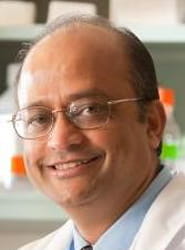Kumar Alagramam, PhD

Kumar Alagramam, PhD
The Anthony J. Maniglia Chair for Research and Education
Professor and Director of Research
Otolaryngology - Head and Neck Surgery, Case Western Reserve University School of Medicine
Graduate Medical Education
- Masters: Biotechnology - University of Tennessee at Knoxville
- PhD: Cell and Molecular Biology - University of Tennessee at Knoxville
Postdoctoral Training
- Oak Ridge National Laboratory, Oak Ridge, Tennessee
- Case Western Reserve University, Cleveland, Ohio
Bio
Dr. Kumar Alagramam earned his Masters in Biotechnology and PhD in Cell and Molecular Biology from the University of Tennessee at Knoxville . He received postdoctoral training at the Oak Ridge National Laboratory, Oak Ridge, Tennessee, and Case Western Reserve University.
The long-term goal of the lab is to understand the genetic program associated with hair cell development and function in the inner ear. Dr. Alagramam has 18 years' experience in mouse genetics and molecular biology. He has considerable experience with mouse and guinea pig models of hearing loss, especially with the mouse model for deafness in Ushers. His work led to the discovery of protocadherin 15 (Pcdh15) and its association with deafness in mice and humans in 2001. From 2002-06, he reported on the identification of mouse mutants carrying different alleles of Pcdh15, and the detailed analysis of hair cells from these alleles demonstrated that mutation in Pcdh15 affects hair bundle morphology and polarity. The current focus of Dr. Alagramam's lab is to understand the precise role of Pcdh15 in hair bundle morphogenesis and mechanotransduction.
More recently (2007-present), he also focused on a mouse model for deafness in Usher 3A, which is caused by a mutation in the human clarin-1 gene. Dr. Alagramam's lab was the first to characterize a mouse model for inner ear dysfunction in Usher 3A that showed how mutation in clarin-1 affects hair cell morphology and function. However, the function of clarin-1, a four-transmembrane protein, in hair cells is unknown.
Honorable Mention
- 2003-Present: Director of Research, Otolaryngology
- 2003-Present: Co-founder and organizer “The Mouse as Instrument of Ear Research” workshop at the Jackson Laboratory, Bar Harbor, ME
- 2008-Present: The Maniglia Endowed Chair for Research and Education, Otolaryngology
- June 2011: Awarded Tenure
- July 2011-June 2015: Permanent member of the Auditory Study Section, NIDCD


